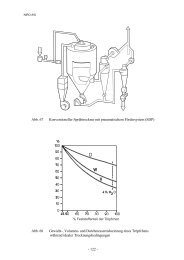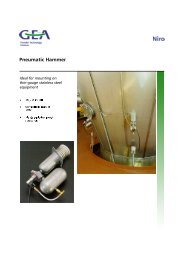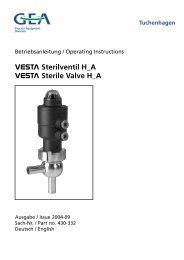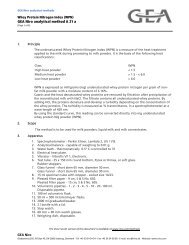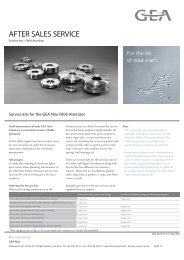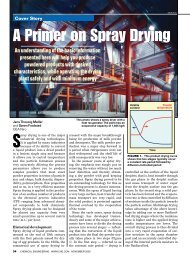41119_Niro jubilaeumsbog_blok_uk - GEA Niro
41119_Niro jubilaeumsbog_blok_uk - GEA Niro
41119_Niro jubilaeumsbog_blok_uk - GEA Niro
You also want an ePaper? Increase the reach of your titles
YUMPU automatically turns print PDFs into web optimized ePapers that Google loves.
<strong>Niro</strong> strikes while the iron is hot<br />
<strong>Niro</strong> has created a unique position for itself as the leading supplier<br />
of spray drying plants for the production of hard metal powders.<br />
<strong>Niro</strong> has always had many irons in the fire – also when it<br />
comes to the spray drying of hard metals, which are used<br />
within the mining and tooling industries. When a smith<br />
stands at the lathe to work metal into tools, for example, he<br />
uses a cutting flat. The cutting flat is a tool that is used in a<br />
lathe to work on the metal object one wants to shape into<br />
another defined form. Hard metals are characterized by having<br />
great strength and hardness and are very suitable for making<br />
cutting flats for shaping metal and for mining equipment.<br />
Cutting flats and tools of hard metal are typically processed<br />
by pressing the hard metal powder into the desired object.<br />
The particle size of the hard metal powder being pressed<br />
greatly influences the physical qualities one can obtain. A<br />
fine hard metal powder typically has greater hardness and<br />
resistance against wear in the finished cutting flat. <strong>Niro</strong>’s<br />
spray drying plants have proven especially suitable for obtaining<br />
a well-defined particle size of the hard metal powder.<br />
A unique position in the hard metal market<br />
Today <strong>Niro</strong> has a unique position within the spray drying of<br />
hard metals, and during the last 40 years has delivered more<br />
than 120 spray drying plants for hard metals. The hard metal,<br />
cobalt and binding material are initially ground in a liquid<br />
for many hours until the right particle size is obtained.<br />
Then the mixture, called the hard metal feed, is dried in the<br />
spray drying plant. Hard metals are also used for the coating<br />
of metals, which thereby achieve greater mechanical strength.<br />
This means that the metal on a drill or saw, for example, can<br />
54 | 55<br />
be coated with a thin layer of hard metal, which gives it a<br />
very strong surface and thereby makes it more resistant to<br />
wear and tear.<br />
The use of hard metals is growing steadily. In 1930, the world’s<br />
total use of hard metals was 10 tons per year –1,000 tons a<br />
year at the beginning of the 1940s, and 10,000 tons a year at<br />
the beginning of the 1960s. Today approximately 50,000<br />
tons of hard metals are produced per year. Hard metals are<br />
so valuable that a very large part of the used cutting flats is<br />
collected by the hard metal companies and reused for the<br />
production of new cutting flats.<br />
About hard metal<br />
• Hard metals have different names, such as tungsten or<br />
wolfram, and the latter is not randomly named. Wolfram<br />
is Scottish and means wolf froth, which refers to the<br />
metal being so hard to dig out of the ground that back in<br />
the old days it simply “ate” the shovels, like a wolf consumes<br />
a sheep.<br />
• Wolfram was first isolated in 1781 by the Swedish<br />
pharmacist Carl Wilhelm Scheele.<br />
• In 1909 an American, W.D. Coolidge, succeeded in using<br />
metallic wolfram for filaments that could be used in<br />
incandescent lamps.<br />
• Wolfram can be found in several countries, while China<br />
has approximately 60 percent of the known wolfram<br />
reserves.



